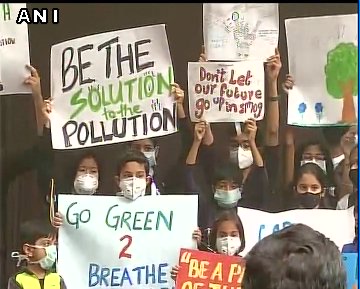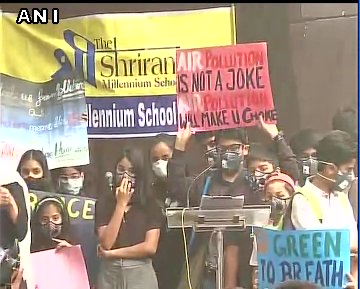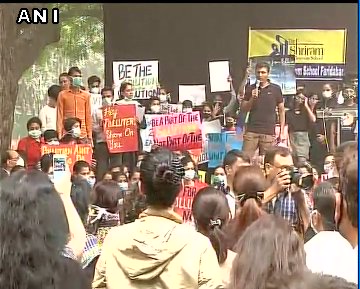Delhi has earned the unenviable distinction of becoming the most polluted city on Earth this month, as air quality has reached epically bad proportions.
On November 8, pollution surged so high that some monitoring stations reported an Air Quality Index of 999, way above the upper limit of the worst category, Hazardous. (An extra-sensitive air quality instrument at the US embassy got a reading of 1,010, as you can see in the chart below.)
/cdn.vox-cdn.com/uploads/chorus_asset/file/9729937/air_quality__2_.jpg)
United Airlines cancelled its flights to India’s capital because of poor air quality. Visibility was so bad that cars crashed in pileups on highways and trains had to be delayed and cancelled.
The airborne particles and toxic chemicals that make up the smog have choked the 19 million residents of the metropolitan area, where merely breathing the air was, at its worst, like smoking 50 cigarettes in a day. Hospitals reported a 20 percent surge in patients with pollution-related illnesses, and doctors have declared a public health emergency.
Delhi’s chief minister went as far as to call his city a “gas chamber”:
“You can’t see very far ahead of you,” Manon Verchot, a former colleague of mine who leads the 20-person video team at the Hindustan Times, told me. “In terms of how it affects people in Delhi, everyone is sick. Half of my team is down right now.”
The grey smoke and haze was so terrible that the US State Department, which has its own air quality monitoring stations in India, installed air filters for its staff at in their offices and homes. Costa Rica’s ambassador to India, Mariela Cruz Alvarez, described in a viral blog post how she developed a serious respiratory infection and had to decamp to South India. “I´m used to living in paradise and suddenly India has become a threat to my health and the health of my friends and colleagues,” she wrote.
More than an inconvenience, air pollution is indeed a major medical hazard. The Lancet Commission on pollution and health reported 9 million premature deaths stemming from air pollution in 2015. More than 2.5 million of these deaths were in India, the most in any single country.
As of November 21, the air quality index was at 326 — far below the peak on November 8, but still in the Hazardous category. Yet Delhi is not out of the woods. The Business Standard reports that Delhi Environment Minister Imran Hussain warned in a letter that “...ambient air quality may once again worsen in the coming weeks.”
Measuring Delhi’s air against some of the other most polluted cities in the world, however, is difficult. Not everyone tracks pollution as well nor is it tracked by the same metrics. The World Health Organization, for example, ranked Zabol, Iran, as having the worst particulate air pollution in the world, but that was an annual average, the number was from 2012, and it was extrapolated from another measurement.
/cdn.vox-cdn.com/uploads/chorus_asset/file/9735507/Screen_Shot_2017_11_22_at_10.30.35_AM.png)
Meanwhile, the highest daily particulate pollution record was set in Shenyang, China, back in 2015.
So why did it get so bad in Delhi this year? Turns out this oppressive smog is a pungent combination of an ancient farming technique and the residues of modern urban living. But the Indian government has also failed to find ways to control the well-understood sources of pollution, which has allowed the situation to grow progressively worse over time.
How Delhi’s air got so toxic, and why it won’t go away
You can see India’s pockets of pollution in this live map from Berkeley Earth, an independent research consortium.
The map shows airborne concentrations of particles with diameters of 2.5 microns or less, also known as PM2.5. These particles can come from different sources — diesel exhaust, natural dust, wildfires — and can lead to heart attacks, strokes, breathing difficulties, and cancer as they penetrate deep into lungs. The concentrations are reported as micrograms per cubic meter.
According to the US Embassy’s measurements, the air in New Delhi reached PM2.5 concentrations of more than 1,200 micrograms per cubic meter, 48 times the guideline value established by the World Health Organization. This is still short of the record set in Shenyang, China, where concentrations topped 1,400 micrograms per cubic meter.
You can see in this screenshot from November 8 how Delhi became the epicentre of hazardous air quality in North India:
/cdn.vox-cdn.com/uploads/chorus_asset/file/9722109/Screen_Shot_2017_11_17_at_4.53.33_PM.png)
“One of the things that are so fascinating is how the pollution is not contained in the cities and it doesn’t even seem to be coming from the cities,” said Elizabeth Muller, executive director of Berkeley Earth.
In fact, much of the pollution is coming from farms in nearby states of Punjab, Haryana, and Western Uttar Pradesh. With the rice harvest over, farmers are burning crop stubble — specifically the remnants of the rice crop to prepare the fields to plant wheat and return nutrients to the soil.
NASA’s Suomi NPP satellite was also able to capture the crop fires in India and Pakistan creating a plume of grey haze during a flyover in October:
/cdn.vox-cdn.com/uploads/chorus_asset/file/9723267/Screen_Shot_2017_11_20_at_5.38.32_PM.png)
But what’s unique about Delhi’s smog is that the smoke from the burning outside the city is mixing with pollution inside the city — from construction, vehicles, and fires the poor use to cook and keep warm. This mix of rural and urban pollution intensifies in the cooler winter months and this year’s air currents through the region have been unusually slow, allowing the dirty air to linger.
North India’s topography also acts as a basin that traps pollution — making it impossible for the millions of people in the region to escape the toxic air. It’s why there are no reports of reverse migration: People retreating from Delhi to rural areas outside the pollution zone so they can breathe cleaner air.
The government is failing to control the pollution, which is leading to popular unrest
Protests have erupted out of anger with the government for failing to deal with the air pollution. Hundreds of people, including children whose schools were closed, took to the streets earlier in the month.
India’s pollution has its roots in politics, as this great piece by four researchers writing in the Washington Post explains. Rural farmers and city dwellers are important constituencies for different parties, and neither side wants to make concessions. Crop burning is often the cheapest way to clear fields, and farmers don’t want to spend more to appease Delhi’s denizens.
At the same time, the country’s Nation Green Tribunal ordered construction to stop in the capital for a few days earlier this month, drawing the ire of construction workers. The tribunal also broached and then, after severe criticism, dropped a car rationing scheme that would let cars with odd-numbered registrations drive only on Mondays, Wednesdays, and Fridays and even-numbered registrations to drive on Tuesdays, Thursdays, and Saturdays.
There are other pollution control laws, but enforcement has been lax for fear of alienating important voting blocs.
Government officials from neighbouring provinces have held tense, fruitless talks on the causes and liability for the pollution for years, but the atrocious air quality in the capital has added a new sense of urgency.
"The country wakes up only if something happens in Delhi," Jairam Ramesh, a member of Parliament and former Minister of Environment, Forests and Climate Change, told the Economic Times.
Technology fixes for pollution also remain a tough sell. As Brad Plumer has explained for Vox, there’s been a lot of discussion about cleaner stoves in India, but for now, burning wood or coal in traditional stoves is considerably cheaper than the alternatives.
Meanwhile, India’s environment minister Harsh Vardhan downplayed the risks from Delhi’s dirty air, telling CNN-News 18 that while high levels of particulates could be harmful, "no death certificate has the cause of death as pollution.”
In fact, researchers say that the links between reduced air quality and premature death are robust. “There are all kinds of things that have been linked pretty convincingly to high levels of air pollution,” said Jason West, an environmental engineer at the University of North Carolina Chapel Hill. “There’s pretty good evidence that lower levels of air pollution are still detrimental.”
The situation is going to get worse before it gets better
West noted that cities in the United States, Western Europe, and Japan have also struggled with deadly air pollution, but the air has cleared as these regions became wealthier, invested in cleaner technologies, and citizens called for stricter regulations on emissions.
“Economic development was important, but economic development by itself didn’t solve the problem,” said West. “People demanded cleaner air and cleaner water.”
Environmental activism is growing in India, but there are still other factors that make its situation unique. One is the sheer number of people — 1.3 billion and growing — and the staggering patterns of rural to urban migration.
More Indians are cramming into smog-shrouded cities, which means more people who need housing, more people buying and driving vehicles with few pollution controls, and more people making fires in the city to cook and keep warm.
The increasingly polluted air means people spend more time indoors, which increases energy demand from lighting and air conditioning, leading to more coal and wood use. That creates a feedback loop that exacerbates the whole situation.
“All the suggestions are that India will likely get worse before it gets better,” West said.
The epicentre of global air pollution is also likely to shift further South, and soon cities in Southeast Asia and sub-Saharan Africa may start coughing and wheezing as populations grow and energy consumption ramps up.
The World Health Organization projects that air pollution will continue to be a major killer in years to come, and the worlds poorest will be left gasping.
But in Delhi, life still sputters on. The Delhi half-marathon had a record turnout over the weekend with some of the 34,000 runners showing up to the starting line wearing masks.
/cdn.vox-cdn.com/uploads/chorus_asset/file/9731615/GettyImages_IndiaRace.jpg)
The air quality, for a moment, was merely “unhealthy,” an improvement from earlier in the month.










